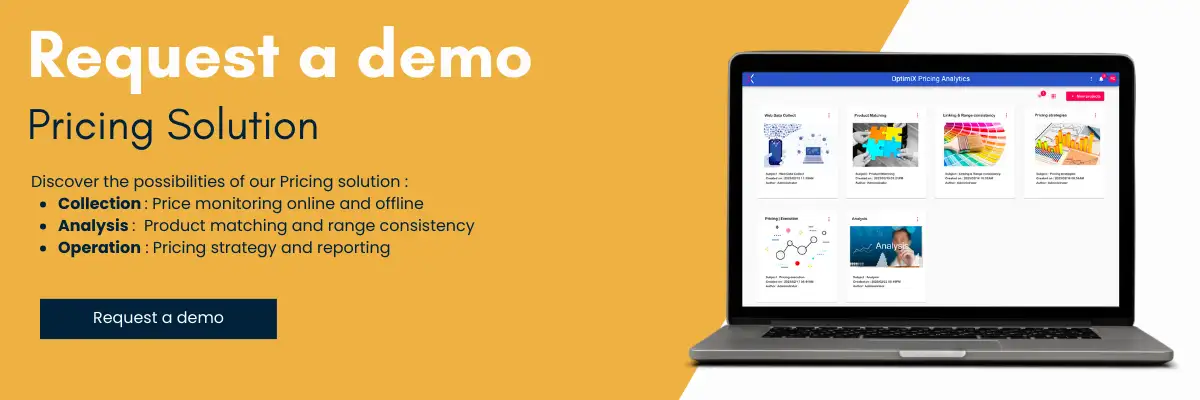Introduction
Whether you’re a retail giant or a promising start-up, determining the price of your products can be a tricky exercise that directly influences consumer perception and, consequently, the impact on your bottom line.
Faced with fierce competition and increasingly sophisticated consumers, it’s imperative to regularly review your pricing strategy to stay relevant in the marketplace.
Discover the multiple criteria in detail that will help you make decisions about your pricing strategy and maximize your results, and where the finesse of your strategy can make the difference between dazzling success and stagnation.
This article explores in depth the 10 essential criteria for assessing the relevance of your approach to retail pricing. From understanding costs to flexibility in the face of market fluctuations, every aspect of your strategy will be scrutinized to help you make informed decisions.
1. Financial indicators
Financial indicators play an important role in our pricing strategy.
Measuring these financial indicators provides a tangible view of the impact of your strategy on your company’s overall financial health. It also enables retailers to estimate the total cost of implementing a pricing strategy.
At the heart of any successful pricing strategy in the retail sector are the financial indicators, which are crucial in assessing a company’s economic health. Fully understanding the costs involved in producing, distributing and marketing a product is the essential first step to competitive and profitable pricing.
Financial indicators such as cost of goods sold, profit margin, etc. breakeven point and return on investment, are the benchmarks that guide pricing decisions. Analyzing this data enables retailers to set prices in line with the company’s financial realities, while ensuring sustainable profitability.
Taking these indicators into account is not limited to simply assessing direct costs. It also includes an understanding of market trends, seasonal variations and consumer buying behavior. A price established in harmony with these indicators can not only maximize profits and strengthen the company’s competitive position in the retail market.
In short, financial indicators provide an indispensable compass to guide strategy. They enable retailers to make informed decisions, adjust their prices in line with economic trends, and ensure sound financial management while remaining competitive in the complex retail landscape. In the following sections, we explore the nine other criteria that complete this financial panorama, offering a global vision for assessing the relevance of a retail pricing strategy.

2. Competitive indicators
In addition to financial indicators, another essential aspect in assessing the relevance of a retail pricing strategy lies in understanding competitive indicators. It is imperative to keep a close eye on the prices charged by direct competitors in order to position your own products wisely in the market.
Analyzing competitive indicators involves scrutinizing the prices of similar products, assessing current promotions and understanding consumers’ perception of value. A delicate balance must be struck between remaining competitive and maintaining acceptable profitability. Prices that are too high can deter customers, while prices that are too low can jeopardize profit margins.
These factors help position your brand in the competitive landscape
These competitive indicators remain important to consider, as they help retailers stay competitive in the face of ever-increasing competition. This comparative perspective provides crucial insights for fine-tuning your strategy.
Competitive indicators go beyond raw numbers. They also encompass aspects such as product differentiation, brand awareness and perceived quality. By taking these factors into account, retailers can fine-tune their strategy to create a unique value proposition that sets them apart from the competition.
The use of competitive analysis tools, competitive intelligence and an understanding of market trends all contribute to a comprehensive assessment of the relevance of a pricing strategy. By integrating these competitive indicators into their decision-making processes, retailers can adapt quickly to market changes and keep pace with consumer expectations.
3. Qualitative indicators
In addition to numerical data, qualitative indicators play a decisive role in assessing a retail pricing strategy. These indicators encompass more subjective but equally crucial aspects, such as perceived quality, customer experience and brand reputation.
Consumers’ perception of quality has a direct impact on their willingness to pay a higher price. A product or service perceived as top-of-the-range can justify higher prices, provided that the perceived quality matches customer expectations. Integrating these qualitative indicators into the pricing strategy enables us to adjust prices in line with the value perceived by consumers.
The customer experience is another fundamental element. Additional services, high-quality customer service or a unique shopping experience can favorably influence the perception of value, justifying higher prices. Qualitative indicators help to assess customer satisfaction, identify areas for improvement and adjust pricing strategy accordingly.
Brand reputation is also crucial in retail. A well-established brand can afford higher prices because of the trust and loyalty it inspires among consumers. Qualitative indicators enable us to measure the strength of the brand and adapt prices to this subjective but powerful dimension.
By integrating qualitative indicators into pricing strategy evaluation, retailers can fine-tune their approach to better meet consumer expectations and build a solid brand image.

4. Performance indicators
One of the key criteria for assessing the relevance of a retail pricing strategy is performance measurement. Beyond theoretical projections, it is imperative to monitor and analyze the concrete results of implementing the pricing strategy in order to continually adjust and optimize the approach.
Key performance indicators (KPIs) need to be defined in advance, based on specific business objectives. These may include measures such as sales, profit margin, average basket, market share and customer loyalty. By analyzing these KPIs on a regular basis, retailers can assess the effectiveness of their pricing strategy.
The use of advanced analysis tools and performance management software can facilitate this evaluation by providing real-time data. These tools make it possible to track price variations, analyze their impact on sales, and quickly identify the adjustments needed to meet targets.
Performance measurement also includes the ability to anticipate and react to market changes. Retailers need to be agile in their price adjustments, whether in response to emerging trends, competitive movements, or changing consumer preferences. A relevant pricing strategy must therefore be constantly aligned with market reality.
By integrating performance measurement into pricing strategy evaluation, retailers can not only adjust their pricing to maximize results, but also ensure that their approach remains agile and adapted to changing retail market conditions.
This performance measurement will give further indication of the success or failure of the pricing strategy they have implemented. Thanks to this additional information, retailers are able to make more informed decisions. predictions on any changes that may be required. These predictions are important for adapting your strategy and staying competitive.
5. Continuous improvement indicators
In today’s fast-moving retail environment, the notion of continuous improvement is a crucial criterion for assessing the relevance of a pricing strategy. Adopting a dynamic, proactive approach, constantly open to optimization, is essential to remain competitive and meet new market challenges.
Continuous improvement begins with the regular collection and analysis of data, both internal and external. Feedback, market trends, customer comments and past performance provide valuable information for adjusting pricing strategy. Retailers need to be ready to question their initial assumptions and make changes as the market evolves.
Flexibility and adaptability are key to continuous improvement. Retailers need to be able to react quickly to changes in the business environment, whether it’s a new consumer trend, a technological innovation or an economic upheaval. This agility enables us to adjust prices in real time, seize new opportunities and minimize potential risks.
Continuous improvement also includes the constant search for best practices. Retailers can draw on the successes and failures of their peers, adopt new technologies and integrate lessons learned to refine their approach to pricing. This requires a corporate culture focused on innovation and adaptability.
When assessing the relevance of a pricing strategy, retailers need to ask themselves whether their approach is designed to evolve with the market. Continuous improvement is not limited to marginal adjustments, but involves constant reflection on how the pricing strategy can be fine-tuned. to meet changing consumer needs and retail market dynamics.
6. Profitability assessment criteria
Assessing the profitability of a project is an essential criterion for judging the relevance of a pricing strategy. This goes beyond the analysis of direct costs, and includes an in-depth understanding of the returns on investment (ROI) associated with the pricing strategy implemented.
Assessing profitability begins with determining the total costs incurred in designing, implementing and maintaining the pricing strategy. These costs include technology, staff training, marketing communications and any other resources invested in the strategy. Retailers need to be able to quantify these costs accurately to calculate ROI.
At the same time, the strategy’s direct financial impact on sales and profit margins needs to be assessed. Data on sales generated by the new strategy, changes in gross profit margin and other key financial indicators help determine whether the strategy is actually contributing to the company’s profitability.
Assessing profitability must also take into account the time factor. Some effects may take time to fully manifest themselves, while others may be immediate. Retailers need to have a long-term vision and be able to adapt to changing market conditions. ready to adjust their strategy according to the results observed over time.
By integrating the notion of project profitability assessment into the pricing strategy, retailers can ensure that every price adjustment is aligned with clear financial objectives and makes a significant contribution to the company’s overall profitability. This criterion offers a valuable financial perspective to guide pricing decisions in the demanding retail sector.

7. Flexibility in the face of fluctuating demand
The volatile nature of the retail market demands constant flexibility in pricing strategy. The ability to adapt quickly to market fluctuations, changes in consumer behavior and competitive movements is a fundamental criterion for assessing the relevance of a pricing strategy.
Flexibility implies responsiveness to rapid market changes. Retailers need to be able to adjust their prices in line with changes in demand, variations in production costs, new consumer trends and competitive developments. This requires a constant monitoring of the commercial landscape, and the implementation of agile mechanisms to quickly update prices.
Pricing strategies must also be flexible in terms of customer segmentation. Consumer needs and behaviors are evolving, and an effective strategy must be able to adapt to meet these changes. Tailoring prices to specific customer segments can be a powerful approach for maximize the value perceived by each customer group.
Technology plays a key role in the flexibility of our pricing strategy. Advanced automation and analysis tools enable retailers to quickly collect data, identify emerging trends and implement price adjustments in real time. A flexible technological infrastructure is therefore essential for agile adaptation to market fluctuations.
By assessing flexibility in the face of market fluctuations, retailers can determine whether their pricing strategy is designed to thrive in an ever-changing business environment. The ability to anticipate, react quickly and adjust strategy in line with market dynamics contributes not only to the relevance, but also to the sustainability of a pricing strategy in the demanding retail sector.

8. Brand image criteria
The way prices are positioned in the market plays a crucial role in the overall perception of the brand and its products. Price positioning strategy, as a key evaluation criterion, consists in determining how prices contribute to the retailer’s overall image and its differentiation from the competition.
An effective positioning strategy begins with a thorough understanding of the brand’s overall positioning. Retailers need to clearly define whether they want to be perceived as a high-end option, an economical alternative, or whether they are aiming for an intermediate positioning. Prices must be aligned with this global strategy to reinforce the brand’s consistent image.
Price positioning is not limited to comparison with the competition, but also encompasses the value proposition perceived by consumers. Retailers need to clearly communicate the benefits and unique features of their products to justify price positioning. This can include elements such as superior quality, innovative features, or an exceptional customer experience.
Pricing strategies can vary according to product or product category. Some items can be positioned as loss-leader products with attractive prices to attract customers, while others can be positioned as premium products with higher margins. Segmentation and understanding of the different product ranges allow us to a more nuanced price positioning strategy.
By assessing price positioning strategy, retailers can ensure that their prices are consistent with their overall brand image, and reinforce the value perceived by consumers. A well-positioned pricing strategy helps create a distinctive brand identity and build strong customer relationships, reinforcing competitiveness in the retail market.
9. The importance of customer reviews : A cornerstone of a successful pricing strategy
In today’s digital age, where the voice of the consumer resonates through online platforms, the importance of customer reviews cannot be underestimated as part of a successful pricing strategy for retailers. These reviews provide valuable information on consumer perception, satisfaction and the value they place on products, directly influencing a brand’s reputation.
Customer reviews have become major trust indicators for consumers. When customers share their buying experiences, including their perception of value for money, this creates a source of authentic information for other potential consumers. A well-tuned pricing strategy must take these opinions into account to reflect customer expectations and maintain a positive relationship with them.
Analysis of customer reviews can offer crucial insights into the perception of product value versus price. Retailers can identify the strengths and weaknesses of their pricing strategy by examining comments on price, perceived quality, and comparison with other options on the market. This in-depth analysis enables us to adjust our strategy to better meet consumer expectations.
Customer reviews are also a powerful tool for adjusting prices in line with market trends. Retailers can be alerted to rapidly changing consumer preferences, new pricing expectations and competitive adjustments through online feedback. This agility in theadjusting prices in response to customer feedback helps maintain competitiveness in the retail market.
Integrating customer reviews into your pricing strategy is not just a question of reactivity, but also of proactivity. By actively encouraging customers to share their views on pricing, and using this feedback to fine-tune strategy, retailers can demonstrate that they are genuinely listening to consumer needs, thereby building trust and loyalty.
By assessing the importance of customer reviews, retailers can adjust their pricing strategy to more accurately reflect consumer expectations. Active listening and taking into account customer feedback not only improves customer satisfaction, but also helps to maintain a positive brand image in an increasingly transparent retail landscape influenced by the online community.

10. Monitoring sales targets: the backbone of a successful pricing strategy
At the heart of any effective pricing strategy for retailers are commercial objectives. These objectives define the company’s direction and aspirations, and the pricing strategy must be carefully aligned with these objectives in order to to ensure sustained growth and lasting success.
Sales targets can vary considerably from one brand to another. Some may aim for rapid customer expansion, while others may seek to consolidate their position in a specific market. Brands may also have profitability, market share or competitive positioning objectives. The pricing strategy must be designed to support these objectives in a coherent way.
Pricing must be closely linked to sales targets. If the aim is to attract new customers, attractive prices or special offers may be preferred. For a brand seeking to position its products as top-of-the-range, higher prices may be justified, provided they offer a corresponding perceived value.
The importance of business objectives also lies in the need to ensure the company’s financial sustainability. An over-aggressive pricing strategy to gain market share quickly can compromise long-term profitability. Conversely, prices that are too high can deter customers and hamper growth.
The flexibility of the pricing strategy in relation to business objectives is also crucial. Retailers must be prepared to adjust their strategy in line with market trendschanges in consumer demand and adjusted corporate objectives. This requires close collaboration between sales, marketing and finance teams.
Constant measurement of performance against business objectives is a key element in this assessment. Retailers need to keep a close eye on success indicators, whether in terms of sales, profitability, market share or other specific targets. Regular analysis of this data enables us to adjust pricing strategy according to observed results.
By assessing the importance of commercial objectives in pricing strategy, retailers can ensure that their pricing approach is a catalyst for achieving these objectives, rather than an obstacle. A pricing strategy well aligned with business objectives contributes to the company’s strategic growth and long-term competitiveness in the retail market.
This concludes our exploration of the 10 essential criteria for assessing the relevance of a pricing strategy in the dynamic retail sector. By judiciously integrating these criteria into their decision-making, retailers can perfect their pricing approach and position themselves advantageously to meet market challenges while capitalizing on emerging opportunities.
----------------------------
Navigating the demanding retail landscape, the development of a relevant pricing strategy is emerging as an inescapable challenge for retailers. The 10 criteria we have explored offer a comprehensive roadmap, from consideration of financial and competitive indicators to proactive integration of customer feedback, flexibility in the face of market fluctuations and alignment with business objectives.
The key to success lies in the ability to orchestrate these criteria synergistically. Successful retailers understand that pricing strategy cannot be static, but rather must evolve in response to market signals, customer feedback and ever-changing business objectives.
By deploying an integrated approach, brands can adjust their prices based on financial indicators while maintaining competitive competitiveness. They can listen carefully to customer feedback to refine their value proposition and remain agile in the face of market developments. Additionally, by constantly keeping business goals in mind, brands can ensure that their pricing strategy serves as a strategic lever for achieving these objectives.
In this context, the success of a pricing strategy is not only measured by its ability to generate revenue, but also by its adaptability, its responsiveness to customer feedback and its alignment with the overall vision of the company. business. By combining these elements, retailers can truly establish a solid foundation for sustained growth and leadership in the ever-changing retail sector.
So, by following these 10 criteria as a guide, retail brands can not only set prices, but sculpt an exceptional customer experience and build a successful future in the competitive retail market.




